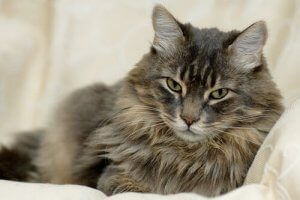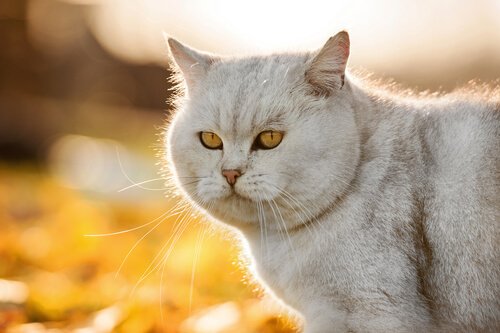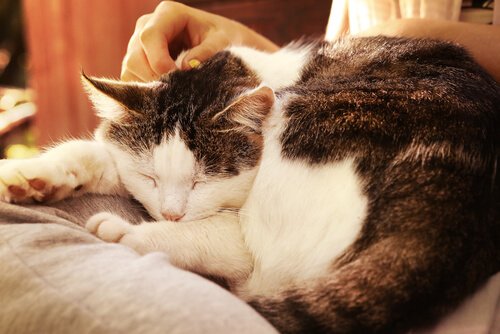Learn Everything About Your Cat's Hair

A cat’s hair can have different lengths and color variations and its bushiness can vary from cat to cat. We’ve found several kinds of crazy myths that have built up around cats’ hair. Because of this, today we’ll tell you about the details and characteristics of feline hair that are definitely worth knowing about!
Properties and characteristics of your cat’s hair
When your cat is strong and healthy, its most appealing feature will likely be its hair. It will surely look beautiful, soft and shiny!

However, cat hair isn’t there for beauty reasons only. Firstly, it serves as the main protection these animals have against several outside influences (UV radiation, hits, etc.). In addition, it also acts as a defense against dehydration.
Cats’ hair also serves as a thermal insulator for both cold and warm weather. For this reason, kittens renew much of their coat when temperatures are more moderate (in Autumn and Spring).
Feline hair, beyond the beauty it provides to these animals, has a lot of interesting facts that you need to know about. You’ll learn all about it in this article.
Some interesting facts about feline hair
Here are some other interesting properties regarding cats’ hair.
- It’s used by the animal to communicate. When a cat is upset or angry, it bristles its hair, for instance.
- The shiny aspect of it comes from the sebaceous glands, which also provide a protective function against infectious agents.
- The seemingly “hairless” cat breeds actually have a very fine coat of hair, which is almost imperceptible to the eye.
Information about your cat’s hair care
Although your purring friend’s tongue is the best tool for grooming its hair, it’s always better to give him a helping hand.
Depending on the length of his coat, you’ll need to brush it more or less frequently. Nevertheless, this way you’ll be able to:
- Remove dead hair and dirt
- Avoid knots
- Prevent your cat swallowing too much hair
During their hair shedding season, cats can ingest more than half of the dead hairs they lose. This is how those terrible hairballs can form in the stomach, for instance. In addition, if these hairballs aren’t expelled through the mouth, they can cause intestinal obstructions.
False beliefs about cats’ hair
Unfortunately, cat hair often has a bad reputation. Maybe it’s because it falls out a lot. Certainly, someone who has kittens can attest to the fact that their fallen hair gets everywhere.
Most people think that this animal’s hair produces allergies. However, the allergenic agent is in fact found in the skin and saliva of the kitty, not the hair.
On the other hand, there are other false beliefs about cat hair that deserve to be disproved:
- It doesn’t transmit pulmonary fibrosis, toxoplasmosis or any other disease
- Cat hair won’t cause blindness if it gets in your eyes
- It doesn’t cause female infertility
- If you swallow it, no cysts or hairballs will form anywhere in your body
- It doesn’t cause asphyxia in babies
Be aware if your cat’s hair loses its shiny aspect and softness
The softness and shiny aspect of your cat’s hair reveals its healthy condition. In other words, if it becomes opaque and dirty-looking, then it’s a sign that something is wrong with your pet.
The reasons may be:

- Inadequate diet. Consult your veterinarian about the best food for your pet according to age, size, activity level, etc.
- Overweight. If the animal is very fat, it may not be able to groom certain parts of its body because it can’t reach them.
- Age. Older cats lose flexibility and may have a bone problem that makes them desist from cleaning certain areas that are farther away than they can reach.
- Diseases. We’re not only referring to dermatological problems. Maybe the cat doesn’t feel well because it has a serious pathology and has lost its desire to groom itself.
In any case, be sure to make an appointment with the veterinarian in order for the animal to overcome its health problems and be able to have a soft, shiny and beautiful coat again.
A cat’s hair can have different lengths and color variations and its bushiness can vary from cat to cat. We’ve found several kinds of crazy myths that have built up around cats’ hair. Because of this, today we’ll tell you about the details and characteristics of feline hair that are definitely worth knowing about!
Properties and characteristics of your cat’s hair
When your cat is strong and healthy, its most appealing feature will likely be its hair. It will surely look beautiful, soft and shiny!

However, cat hair isn’t there for beauty reasons only. Firstly, it serves as the main protection these animals have against several outside influences (UV radiation, hits, etc.). In addition, it also acts as a defense against dehydration.
Cats’ hair also serves as a thermal insulator for both cold and warm weather. For this reason, kittens renew much of their coat when temperatures are more moderate (in Autumn and Spring).
Feline hair, beyond the beauty it provides to these animals, has a lot of interesting facts that you need to know about. You’ll learn all about it in this article.
Some interesting facts about feline hair
Here are some other interesting properties regarding cats’ hair.
- It’s used by the animal to communicate. When a cat is upset or angry, it bristles its hair, for instance.
- The shiny aspect of it comes from the sebaceous glands, which also provide a protective function against infectious agents.
- The seemingly “hairless” cat breeds actually have a very fine coat of hair, which is almost imperceptible to the eye.
Information about your cat’s hair care
Although your purring friend’s tongue is the best tool for grooming its hair, it’s always better to give him a helping hand.
Depending on the length of his coat, you’ll need to brush it more or less frequently. Nevertheless, this way you’ll be able to:
- Remove dead hair and dirt
- Avoid knots
- Prevent your cat swallowing too much hair
During their hair shedding season, cats can ingest more than half of the dead hairs they lose. This is how those terrible hairballs can form in the stomach, for instance. In addition, if these hairballs aren’t expelled through the mouth, they can cause intestinal obstructions.
False beliefs about cats’ hair
Unfortunately, cat hair often has a bad reputation. Maybe it’s because it falls out a lot. Certainly, someone who has kittens can attest to the fact that their fallen hair gets everywhere.
Most people think that this animal’s hair produces allergies. However, the allergenic agent is in fact found in the skin and saliva of the kitty, not the hair.
On the other hand, there are other false beliefs about cat hair that deserve to be disproved:
- It doesn’t transmit pulmonary fibrosis, toxoplasmosis or any other disease
- Cat hair won’t cause blindness if it gets in your eyes
- It doesn’t cause female infertility
- If you swallow it, no cysts or hairballs will form anywhere in your body
- It doesn’t cause asphyxia in babies
Be aware if your cat’s hair loses its shiny aspect and softness
The softness and shiny aspect of your cat’s hair reveals its healthy condition. In other words, if it becomes opaque and dirty-looking, then it’s a sign that something is wrong with your pet.
The reasons may be:

- Inadequate diet. Consult your veterinarian about the best food for your pet according to age, size, activity level, etc.
- Overweight. If the animal is very fat, it may not be able to groom certain parts of its body because it can’t reach them.
- Age. Older cats lose flexibility and may have a bone problem that makes them desist from cleaning certain areas that are farther away than they can reach.
- Diseases. We’re not only referring to dermatological problems. Maybe the cat doesn’t feel well because it has a serious pathology and has lost its desire to groom itself.
In any case, be sure to make an appointment with the veterinarian in order for the animal to overcome its health problems and be able to have a soft, shiny and beautiful coat again.
All cited sources were thoroughly reviewed by our team to ensure their quality, reliability, currency, and validity. The bibliography of this article was considered reliable and of academic or scientific accuracy.
- Jordan Vet Hospital. (2018). Grooming and Coat Care for Your Cat. Recuperado el 18 de marzo de 2022, disponible en: https://www.jordanveterinaryhospital.com/uploads/1/3/3/6/133614923/grooming_and_coat_care_for_your_cat.pdf
- Dallas, S., North, D. & Angus, J. (2006) Grooming Manual for the Dog and Cat. Blackwell Publishing: UK.
This text is provided for informational purposes only and does not replace consultation with a professional. If in doubt, consult your specialist.








